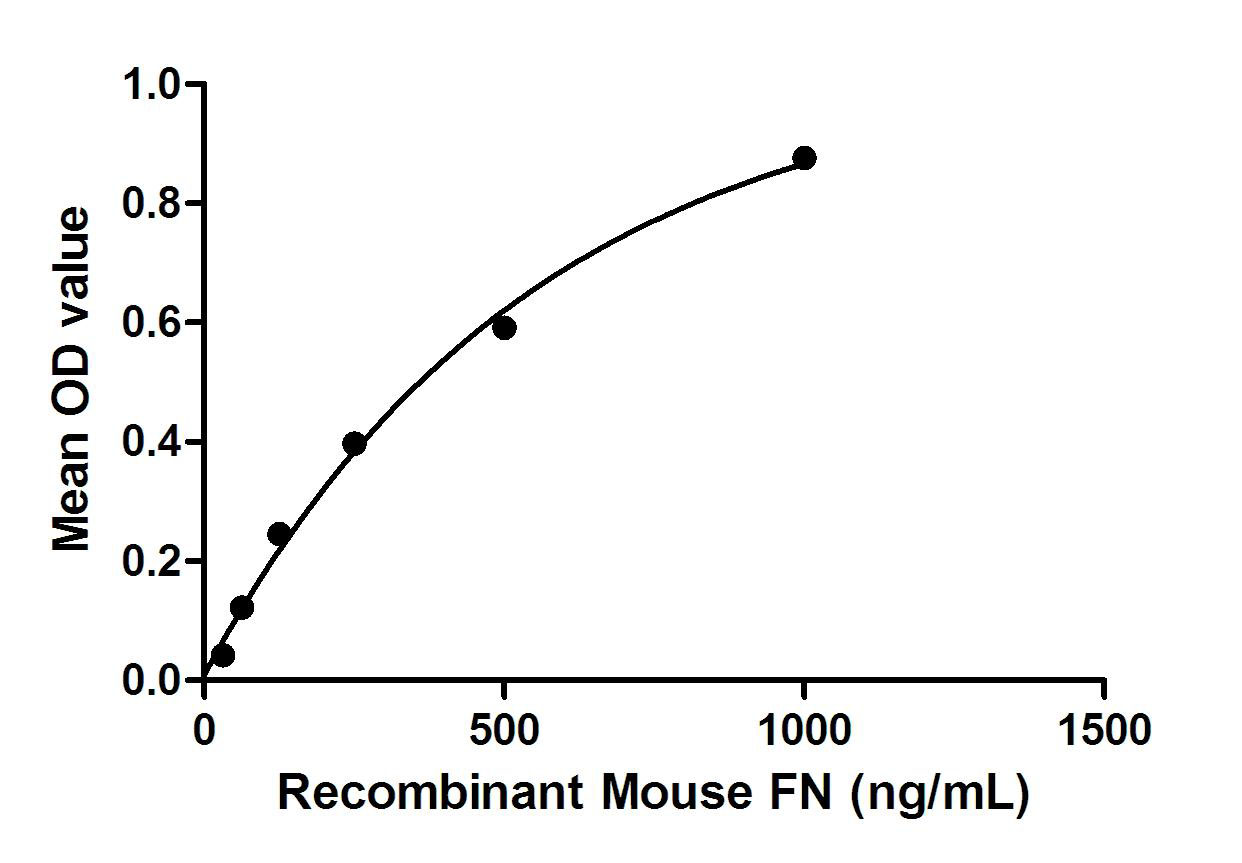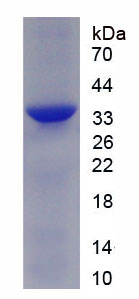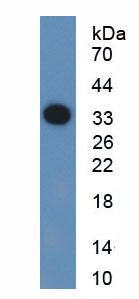Active Fibronectin (FN) 

FN1; CIG; FINC; LETS; MSF; GFND2; Anastellin; Migration-Stimulating Factor; Cold-Insoluble Globulin; Large, External, Transformation-Sensitive Protein
- UOM
- FOB US$ 252.00 US$ 630.00 US$ 1,260.00 US$ 3,780.00 US$ 9,450.00
- Quantity
Overview
Properties
- Product No.APA037Mu01
- Organism SpeciesMus musculus (Mouse) Same name, Different species.
- ApplicationsCell culture; Activity Assays.
Research use only - DownloadInstruction Manual
- CategorySignal transductionInfection immunity
- Buffer Formulation20mM Tris, 150mM NaCl, pH8.0, containing 1mM EDTA, 1mM DTT, 0.01% SKL, 5% Trehalose and Proclin300.
- Traits Freeze-dried powder, Purity > 97%
- Isoelectric Point5.9
Sign into your account
Share a new citation as an author
Upload your experimental result
Review

Contact us
Please fill in the blank.
Activity test

Fibronectin (FN) is a high-molecular weight (~440kDa) glycoprotein of the extracellular matrix that binds to membrane-spanning receptor proteins called integrins. Fibronectins bind cell surfaces and various compounds including collagen, fibrin, heparin, DNA, and actin. Fibronectin has numerous functions. For example, it involved in cell adhesion, cell motility, opsonization, wound healing, maintenance of cell shape, and so on. Besides, Decorin (DCN) has been identified as an interactor of FN, thus a binding ELISA assay was conducted to detect the interaction of recombinant mouse FN and recombinant mouse DCN. Briefly, FN were diluted serially in PBS, with 0.01% BSA (pH 7.4). Duplicate samples of 100μL were then transferred to DCN-coated microtiter wells and incubated for 2h at 37℃. Wells were washed with PBST and incubated for 1h with anti-FN pAb, then aspirated and washed 3 times. After incubation with HRP labelled secondary antibody, wells were aspirated and washed 3 times. With the addition of substrate solution, wells were incubated 15-25 minutes at 37℃. Finally, add 50µL stop solution to the wells and read at 450nm immediately. The binding activity of FN and DCN was shown in Figure 1, and this effect was in a dose dependent manner.
Figure. The binding activity of FN with DCN.
Usage
Reconstitute in 20mM Tris, 150mM NaCl (pH8.0) to a concentration of 0.1-1.0 mg/mL. Do not vortex.
Storage
Avoid repeated freeze/thaw cycles. Store at 2-8°C for one month. Aliquot and store at -80°C for 12 months.
Stability
The thermal stability is described by the loss rate. The loss rate was determined by accelerated thermal degradation test, that is, incubate the protein at 37°C for 48h, and no obvious degradation and precipitation were observed. The loss rate is less than 5% within the expiration date under appropriate storage condition.
Increment services
-
 BCA Protein Quantification Kit
BCA Protein Quantification Kit
-
 Molecular Mass Marker for Protein
Molecular Mass Marker for Protein
-
 Monoclonal Antibody Customized Service
Monoclonal Antibody Customized Service
-
 Polyclonal Antibody Customized Service
Polyclonal Antibody Customized Service
-
 Protein Activity Test Experiment Service
Protein Activity Test Experiment Service
-
 Electrophoretic Mobility Shift Assay (EMSA) Experiment Service
Electrophoretic Mobility Shift Assay (EMSA) Experiment Service
-
 Buffer
Buffer
-
 Lentivirus Packaging Experiment Service
Lentivirus Packaging Experiment Service
-
 Adenovirus Packaging Experiment Service
Adenovirus Packaging Experiment Service
-
 Real Time PCR Experimental Service
Real Time PCR Experimental Service
-
 Spike RBD Protein (S-RBD)
Spike RBD Protein (S-RBD)
-
 Protein G
Protein G
-
 Protein A
Protein A
Citations
- Advanced oxidation protein products induce mesangial cell perturbation through PKC-dependent activation of NADPH oxidasePubMed: 19019916
- Protein synthesis and secretion in human mesenchymal cells derived from bone marrow, adipose tissue and Wharton's jellyPubmed: 24739658
- Identification of compounds from the water soluble extract of Cinnamomum cassia barks and their inhibitory effects against high-glucose-induced mesangial cells.Pubmed: 24013407
- Bioactive compounds from Cornus officinalis fruits and their effects on diabetic nephropathyScienceDirect: S0378874114002414
- Inhibition by Female Sex Hormones of Collagen Gel Contraction Mediated by Retinal Pigment Epithelial CellsPubmed: 24609629
- Mesenchymal stromal cell proliferation, gene expression and protein production in human platelet-rich plasma-supplemented mediaPubmed:Pmc4130592
- Metabolic and cytoprotective effects of in vivo peri-patellar hyaluronic acid injections in cultured tenocytesPubmed:25333747
- Establishing principles of macromolecular crowding for in vitro fibrosis research of the vocal fold lamina propriaPubmed:25545625
- In vivo bioengineered ovarian tumors based on collagen, matrigel, alginate and agarose hydrogels: a comparative studyPubmed:25634132
- In vivoPubMed: 25634132
- Impact of Nigella Sativa, Omega-3 Fatty Acids and Chromium Picolinate onNF-κB/leptin-insulin Axisin Obese Subjects with Non-alcoholic Fatty Liver DiseaseAjmbr: 3
- Comparative proteomics of milk fat globule membrane in goat colostrum and mature milkPubmed:27173528
- Maternal endothelial damage as a disorder shared by early preeclampsia, late preeclampsia and intrauterine growth restriction.pubmed:27865093
- Effect of panax notoginseng saponins on efficacy and hemorrhagic transformation of rt-PA intravenous thrombolysis in patients with acute ischemic strokeArticle_en:CJFDTotal-XDJB201611014
- Serum fbronectin distinguishes the early stages of hepatocellular carcinomapubmed:28842594
- Pigment epithelium‑derived factor protects human glomerular mesangial cells from diabetes via NOXO1‑iNOS suppression10.3892/mmr.2017.7563
- Tenomodulin is essential for prevention of adipocyte accumulation and fibrovascular scar formation during early tendon healing.pubmed:29022912
- Effects of panax notoginseng saponin on the pathological ultrastructure and serum IL‐6 and IL‐8 in pulmonary fibrosis in rabbitsPubmed:29932250
- Corn silk (Zea mays L.), a source of natural antioxidants with α-amylase, α-glucosidase, advanced glycation and diabetic nephropathy inhibitory activitiesPubmed: 30530231
- Impact of Hydrogel Elasticity and Adherence on Osteosarcoma Cells and OsteoblastsPubmed: 30838809
- TNF-α Regulates ITGβ1 and SYND4 Expression in Nucleus Pulposus Cells: Activation of FAK/PI3K SignalingPubmed: 31111299
- Three kinds of corneal host cells contribute differently to corneal neovascularization
- Effects of autophagy on macrophage adhesion and migration in diabetic nephropathyPubmed: 31352855
- Growth hormone induces Notch1 signaling in podocytes and contributes to proteinuria in diabetic nephropathyPubmed: 31511328
- Fabrication and Evaluation of a Xenogeneic Decellularized Nerve-Derived Material: Preclinical Studies of a New Strategy for Nerve RepairPubmed: 31758411
- Molecular hydrogen regulates PTEN‐AKT‐mTOR signaling via ROS to alleviate peritoneal dialysis‐related peritoneal fibrosisPubmed: 31930571
- Damage-Associated Molecular Patterns and Th-Cell-Related Cytokines Released after Progressive EffortPubmed: 32210109
- Are the Circulating Levels of Copeptin and Fibronectin Dysregulated in Preeclamptic South African Black Women?
- Advanced glycation end-products associate with podocytopathy in type II diabetic patients
- Early mobilization in spinal cord injury promotes changes in microglial dynamics and recovery of motor functionPubmed:35586775








